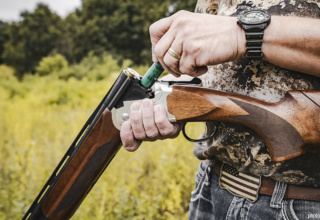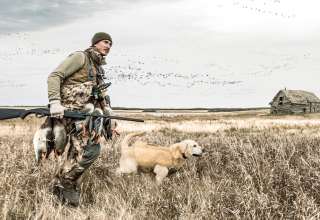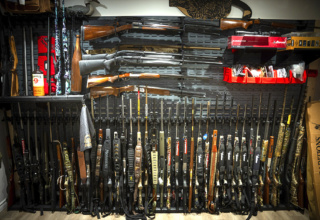Diminishing habitat and agricultural fluctuations along the Gulf Coast make us ask, “Is our duck hunting heritage on the wane?”
by Brad Fenson
We launched the duck boats in a shallow backwater of the big river and loaded dogs, guns, and people for the ride to the blinds. I wasn’t sure what to expect, but as the throttle was pushed towards the floorboards, the boat jumped up on plane and we careened around the current break into the Big Muddy. I was startled as the force of the flowing water threw the boat around like a toy in a bathtub, and to make things more intense, three freight liners were jockeying for position right in front of us to run up the mighty Mississippi River with their cargo.
I was hunting southern Louisiana on a January waterfowl adventure that would be my first experience in the Gulf of Mexico. The boat captain drove with confidence and precision as we ducked big wakes, motored around ships, and shot across the channel into a finger of water no wider than the boat. I felt like I was in an IMAX theatre motoring into the unknown at breakneck speed.
We swapped out the big boat for a shallow duck craft and headed to our blind. The boat fit inside the frame of the blind and large bundles of phragmites filled in the holes to conceal us from all angles.
It didn’t take long to realize the Gulf is a special place. Shorebirds winged past in flocks that numbered in the hundreds, swooping and diving as though choreographed in perfect harmony. The distant sound of ships on the open seas competed with the huge freighters heading up the river. We were tucked away within the central hub of activity and waited patiently for the air show to begin.
First light is always good for hunting, but our guide warned that the birds moved with the tides more than sunrise or sunset, and it didn’t take long for a flock of birds to find our decoys. Dots in the sky turned out to be big gray ducks or gadwall. My guide hissed, “Oh, those are big ducks. Get ready.”
The ducks circled with caution three times before committing to the decoys. Shotguns roared and three of the big grays lay feet up in the decoys. Minutes later, a flock of redheads sped just above the surface of the water. I swung my shotgun hard to unleash a pattern of Winchester Xpert Snow Goose on the biggest drake. My second shot connected on a drake near the back end of the flock, providing a dream double.
Things slowed down once the sun broke the horizon and we had to work for the birds. A drake pintail circled us so many times I started to get dizzy watching it. When it closed the distance, it fell prey to a well-placed pattern of steel.
We waited until almost noon, when the high tide brought a wave of ducks that allowed us to close our limits in a matter of minutes. It was as though someone flicked a switch and the ducks were sent out to feed. They worked the decoys fast and chattered with excitement with whistles and quacks that only a duck can relate to, but we answered.
We hunted three mornings and fished for redfish in the afternoons, providing an outstanding experience that still leaves me wanting to return. After experiencing the Louisiana cast-and-blast, my biggest fear is the Gulf may be changing so fast that I might not get back to experience the amazing diversity and productivity of the briny estuaries in the same way.
Tides are Predictable. Waterfowl and the Future of their Habitat are Not.
Power and politics are stronger than the current of the Mighty Mississippi, and the Gulf is changing so fast that we will be lucky if the next generation will see the same wonders we enjoy today. The region has a history of tumultuous times, dating back to January 8, 1815, when the U.S. Army battled the British Army, known as the Battle of New Orleans. The 1993 movie The Pelican Brief, starring Julia Roberts, Denzel Washington, and Sam Shepard, flirted with the politics of the Gulf and the many factions that dictate its use and management. Unfortunately, the coastal marshes that support an incredible array of flora and fauna, as well as play an integral role in the migration of millions of birds and incredible fisheries, aren’t always the first consideration for the region or how the land and water are managed.
The head of the Ducks Unlimited (DU) Southern Region says, “The persistent losses of over 1.1 million acres of coastal marsh, a decline of nearly 300,000 acres of rice, and the scourge of invasive aquatic species have combined to make the waterfowl habitat of the Gulf Coast one of the most embattled areas on the continent. DU is working to restore coastal marshes for waterfowl and coastal communities. Also, DU is working at an unprecedented scale with the National Resources Conservation Service to assist rice producers in optimizations of their operations to make rice a more viable crop.”
Waterfowl face a changing landscape and habitat loss. The Mississippi Alluvial Valley once boasted over 24 million acres of forested wetland ecosystem, but natural flooding cycles and rerouted water have led to forest harvest and critical loss of habitat. DU’s programs work to protect the remaining forested wetlands and ensure water quality and public hunting opportunities.
Most hunters likely don’t realize the importance of rice production in the United States. Rice is grown in California, the Mississippi Alluvial Valley and the Gulf Coast of Texas and Louisiana. The rice production areas are the three most important wintering areas for waterfowl. The USDA reports that the U.S. produces less than 2% of the rice in the world, but those fields can be responsible for overwintering more than 40% of the dabbling ducks in the Lower 48.
Winter flooded rice fields provide a high food energy for dabbling ducks and geese. Without them, waterfowl populations in the area could not be maintained.
What does it all mean? Make time to hunt the Gulf Coast to experience the wonders of these productive coastal marshes or the flooded rice fields. Support conservation and stand up for what makes our blood flow. If hunters don’t take a stand for waterfowl, who will?
Shotguns take a beating in the mud and salt of the coastal marshes. An autoloader must be able to function under adverse conditions to work flawlessly when the ducks fly. The Browning A5 proved to be saltwater hearty, and never missed a cycle in three days of punishing use.
Winchester Xpert Snow Goose Steel can be described as hard-hitting value. Winchester engineers combined features from the old reliable line of Xpert shotshells with Blind Side to create a new engineered load that is ideal for snow geese, but don’t let the name fool you because it patterns perfect for fast-flying ducks. Snow Goose Steel offers premium performance at a great value, with a diamond-cut wad for dense, downrange patterns and velocities of 1,475 to 1,550 fps.
- For a unique cast-and-blast adventure, contact Cajun Fishing Adventures, South Louisiana.
- To hunt flooded rice or timber, contact Arkansas Duck Masters Guide Service.
























